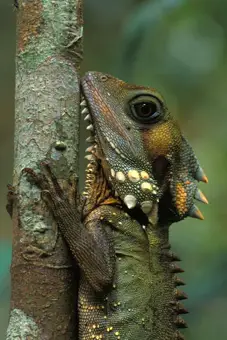The Boyds Forest Dragon (Hypsilurus boydii) from Queensland’s wet tropics is already a species under threat. An international group of scientists has predicted that a quarter of the world’s land animals and plants will not survive the onslaught of climate change. It is likely that over a million species will go extinct by 2050. The dragon is likely to be one of the million doomed to extinction.
The dragon grows up to a length of half a metre, and has a row of large tooth-like spines running under the ‘throat’ with prominent flattened scales along the back, and the scales behind the neck are greatly enlarged.

Ribbit Photography
Lizards are often referred to as cold-blooded because, unlike the so-called warm-blooded mammals and birds, they do not produce their body heat internally. Instead, they bask in the sun, its warm rays raising their body temperature until they’re hot enough to move around, which is called thermoregulating. In rain forests, there is not always sunlight as the thick canopy blocks most of it. So like some other lizard species, the Boyds forest dragon use another way of warming, called thermoconforming. This is where the lizard’s body temperature simply conforms to that of the air around it.
Climate change is going to have a catastrophic effect on the long term biodiversity of the Australian Wet Tropics rain forests, even with a temperature increase of around 2ºC. The dragon is at risk because of how it regulates its body temperature, and ninety per cent of its habitat could be unsuitable by 2050.
Habitat and Distribution: (Source: Environmental Protection Agency)
• It is only found in the rainforests of north eastern Queensland, restricted in area from just south of Cooktown, to the Atherton Tableland region and south to Paluma near Townsville.
• It spends most of its time in trees and due to its camouflage it is often very hard to see and thus tends to go unnoticed. However they can more easily be spotted basking in the sun on the sides of roads and walking tracks where it may be lying on the ground to absorb some of the heat radiating form the surface.
• Forest dragons are territorial with the larger male territory usually containing one or more small female territories. Sometimes lizards have one or two favourite trees within their territory to which they will regularly return.
Additional Information:
• Boyds forest dragon belongs to a South-east Asian group of lizards, although our species (Hypsilurus (Gonocephalus) boydii) is endemic to the Wet Tropics region of North Queensland.
• The male has a home range of about 1000 square metres. Female ranges are slightly smaller. Home ranges of the same sexes do not overlap but larger male territories often contain one or more female territories. Movements within the territories vary with season with dragons travelling 100m or more during summer days but relatively little in winter.
• These lizards spend much of their time perching on the side of tree trunks just one or two metres from the ground waiting to ambush prey. They sometimes have favourite trees to which they will regularly return.
• The male is larger than the female and can be distinguished by its larger, blocker head. Both sexes have a large yellow dewlap below their chins which they can erect using a bone called the hyoid. The dewlap is used for displaying to each other and to scare off predators.
• The lizards mature at about 1-3 years of age. They may live for about five or ten years but this is uncertain.
• In general the Boyds forest dragon relies on its superb camouflage to escape predators. It will usually stay very still, only moving when it is sure it has been spotted. Then it slowly folds in its arms and legs and slides around the back of the tree, keeping the trunk between itself and its observer.
Klaus Toepfer, executive director of the United Nations Environment Programme (UNEP), has stated that the predicted the global biodiversity loss, “underlines again to the world the importance of bringing into force the Kyoto Protocol , the international agreement to cut back greenhouse gas emissions”.
|
Other Species Impacted Upon by Climate Change
Quiver Tree |
